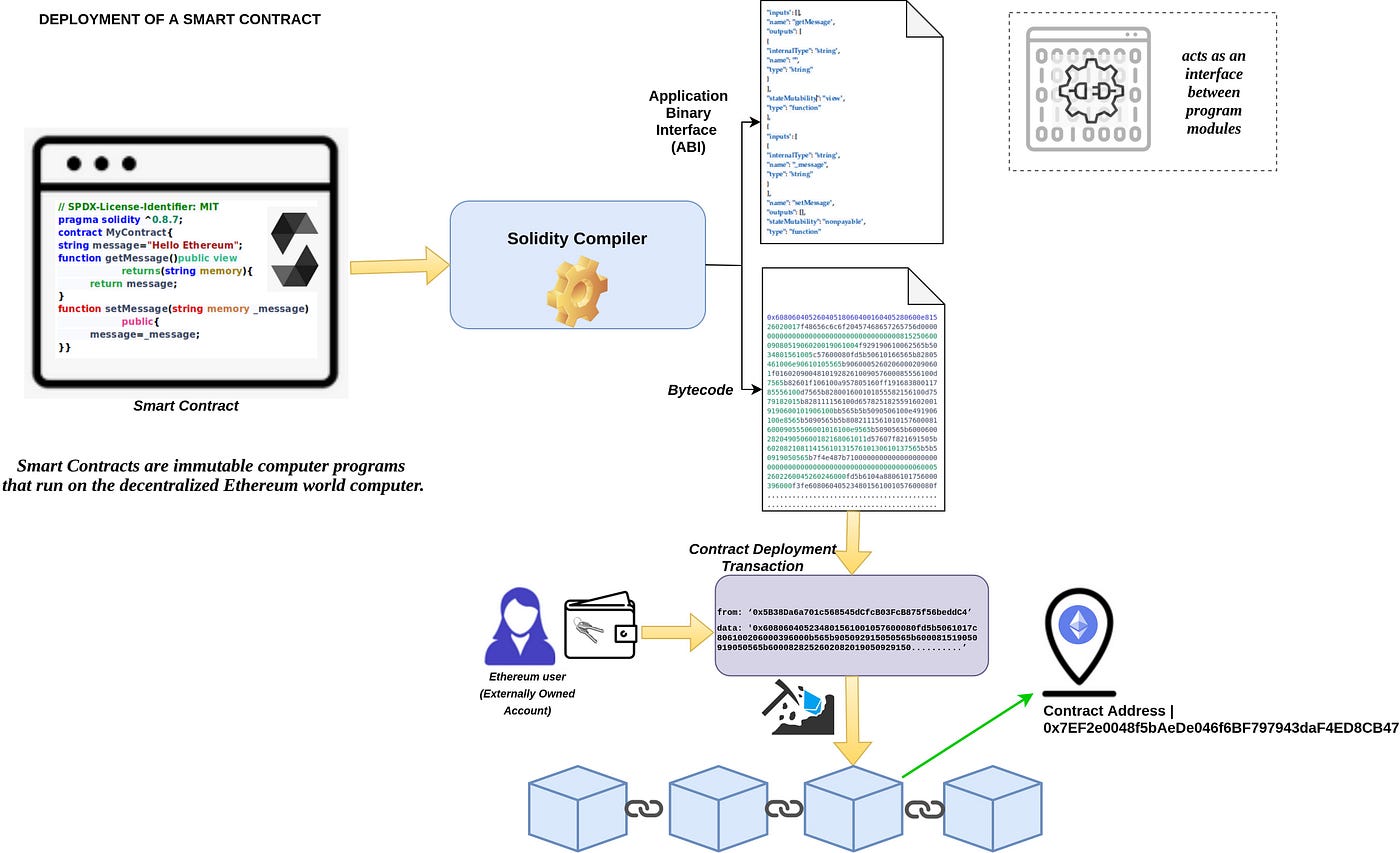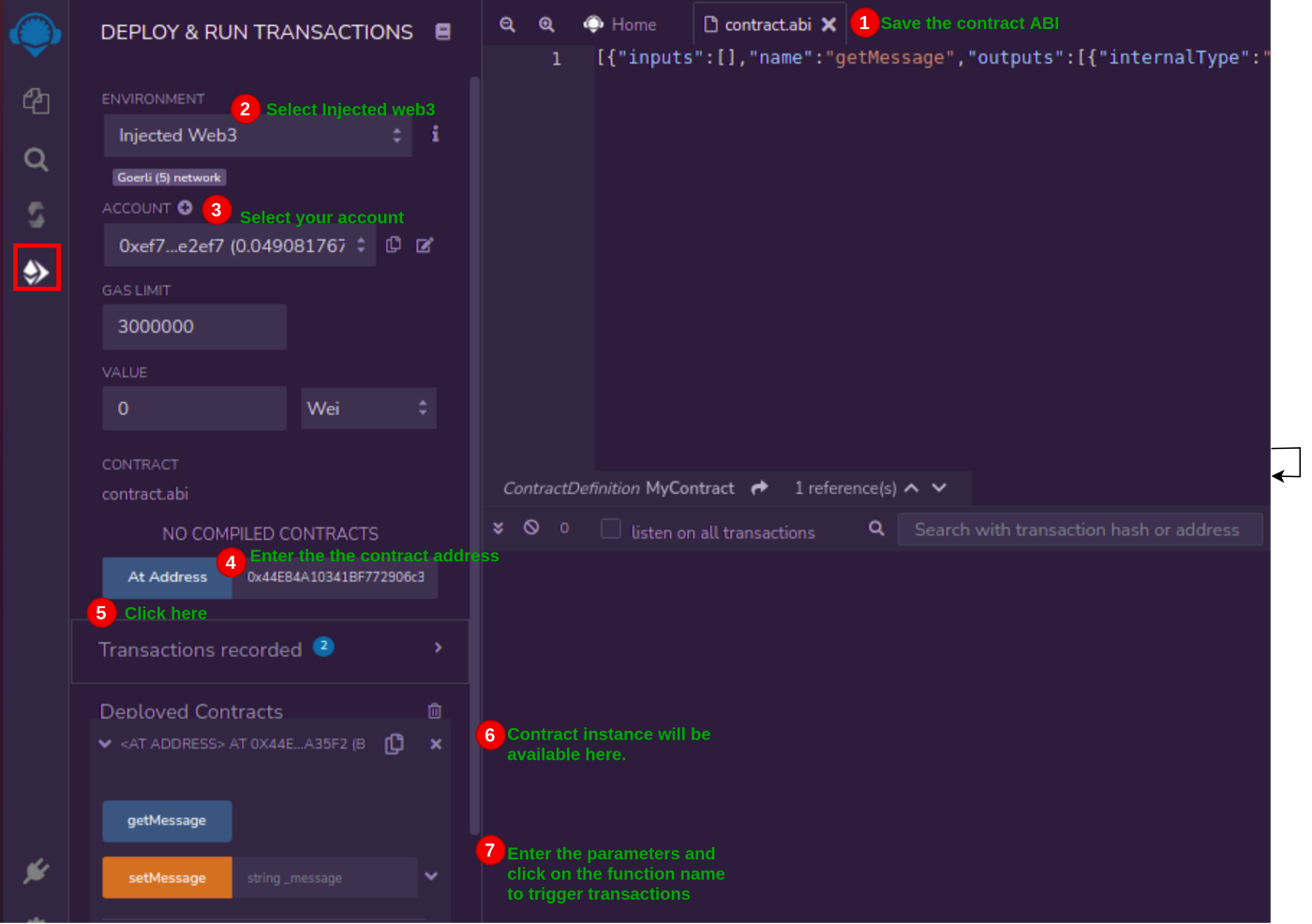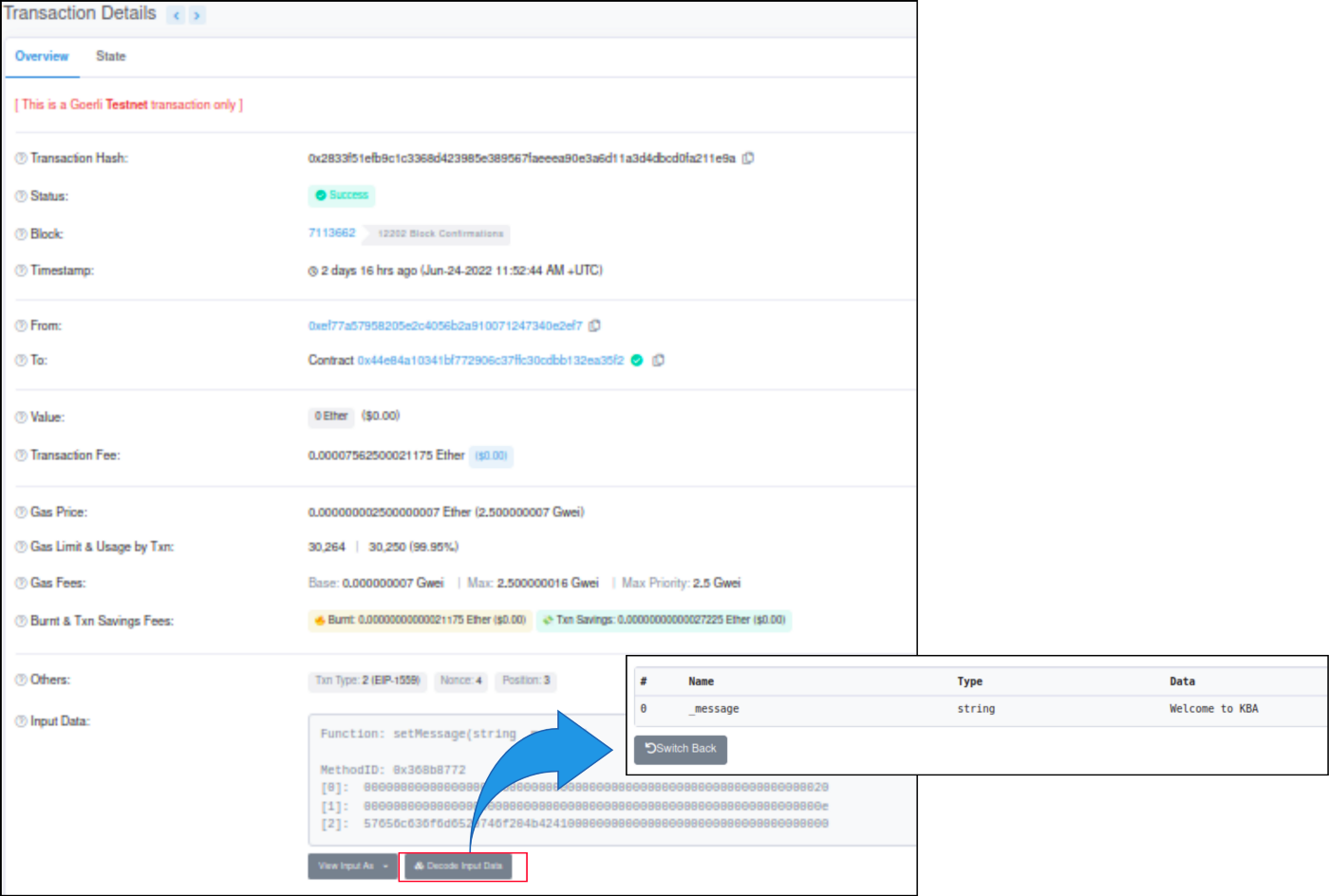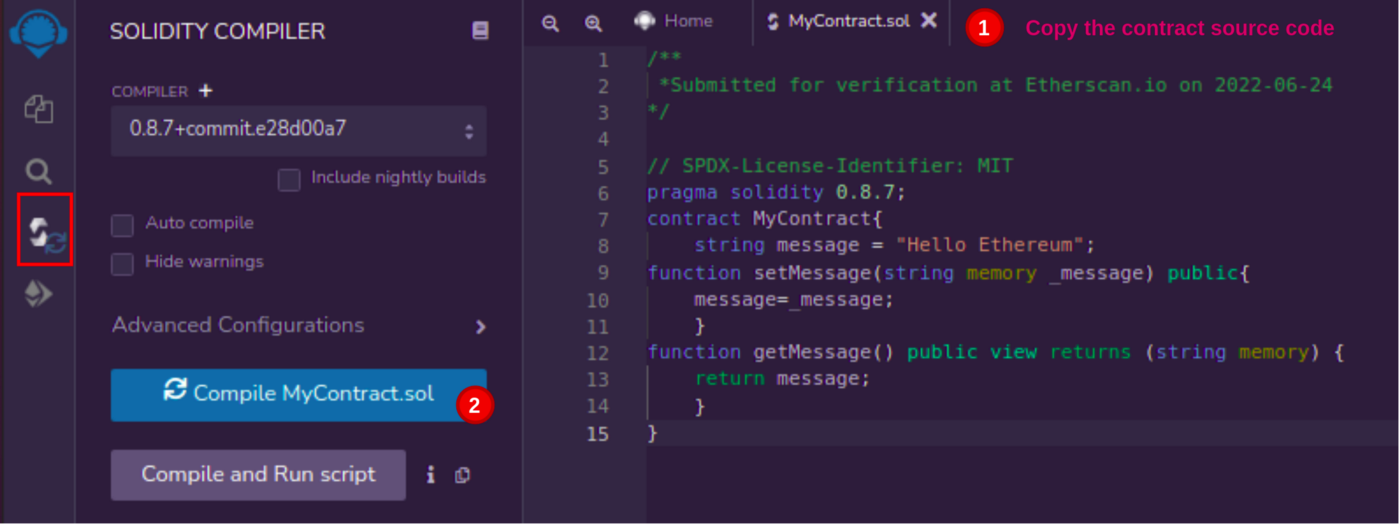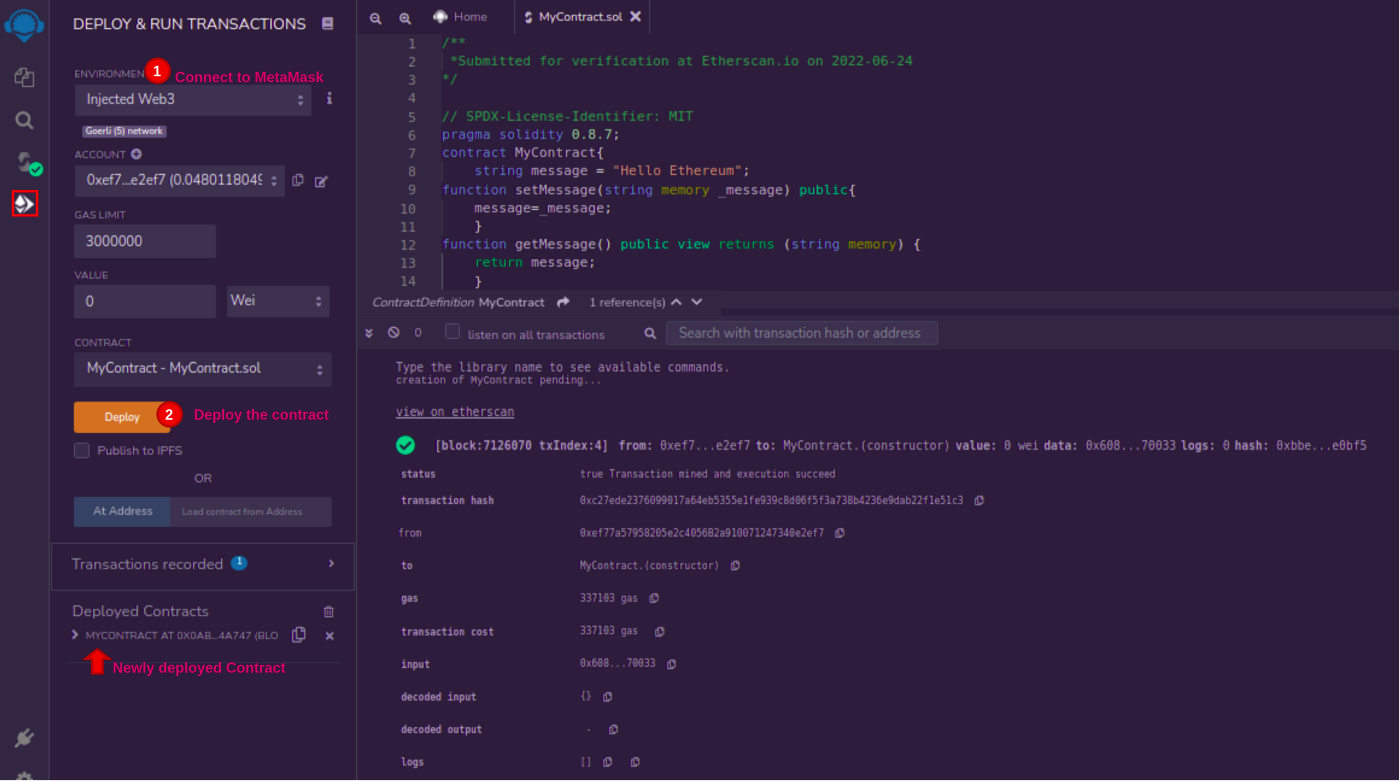| Table of Contents |
|---|
Key Points
...
...
eubof-smart-contracts-paper-2022.pdf link
| View file | ||||
|---|---|---|---|---|
|
Ethereum Concepts
https://ethereum.org/en/developers/docs/intro-to-ethereum/
eubof-smart-contracts-paper-2022.pdf link
| View file | ||||
|---|---|---|---|---|
|
Deprecated > Creating and Deploying Smart Contracts with Solidity - Baeldung - Java interface to create, run Solidity Dapps
https://www.baeldung.com/smart-contracts-ethereum-solidity
https://github.com/eugenp/tutorials/tree/master/ethereum
A smart contract is a stand-alone script usually written in
Solidity and compiled into binary or JSON and
deployed to a specific address on the blockchain. In
the same way that we can call a specific URL endpoint of a
RESTful API to execute some logic through an HttpRequest,
we can similarly execute the deployed smart contract at a
specific address by submitting the correct data along with
the necessary Ethereum to call the deployed and compiled
Solidity function.
see a smart contract as a collection of code stored in the blockchain
network that defines conditions to which all parties using the contract agree upon.
Anyone can deploy a smart contract to the decentralized database for a fee proportional to
the storage size of the containing code. Nodes wishing to use the smart contract must
somehow indicate the result of their participation to the rest of the network.
Solidity – which is a Javascript-like language developed specifically for writing
smart contracts. Solidity is statically typed, supports
inheritance, libraries and complex user-defined types among other features.
deployment
solidity compiler turns code into EVM bytecode, which
can then be sent to the Ethereum network as a deployment
transaction. Such deployments have more substantial
transaction fees than smart contract interactions and must
be paid by the owner of the contract.
Remix IDE
We can use Remix, which's currently the best online IDE and it's effortless to use.
execute a contract from a node
run a client ourselves
OR connect to a remote node using a service like Infura.
Infura is the most straightforward option, so we'll request a free access token. Once we sign up, we need to pick the URL
of the Rinkeby test network:
“https://rinkeby.infura.io/<token>”.
To be able to transact with the smart contract from Java, we need to use a library called Web3j. Here is the Maven dependency:
<dependency>
<groupId>org.web3j</groupId>
<artifactId>core</artifactId>
<version>3.3.1</version>
</dependency>
5.1. Creating a Wallet
5.2. Requesting Ether in the Rinkeby Testnet
5.3. Generating the Smart Contract Wrapper
6. Interacting With the Smart Contract
In our main class, we start by creating a new web3j instance to connect to remote nodes on
the network:
Web3j web3j = Web3j.build(
new
HttpService("https://rinkeby.infura.io/<your_token>"));
We then need to load our Ethereum wallet file:
Credentials credentials = WalletUtils.loadCredentials(
"<password>",
"/path/to/<walletfile>");
Now let's deploy our smart contract:
Greeting contract = Greeting.deploy(
web3j, credentials,
ManagedTransaction.GAS_PRICE, Contract.GAS_LIMIT,
"Hello blockchain world!").send();
Deploying the contract may take a while depending the work in the network. Once is
deployed, we might want to store the address where the contract was deployed. We can
obtain the address this way:
String contractAddress = contract.getContractAddress();
All the transactions made with the contract can be seen in the url:
“https://rinkeby.etherscan.io/address/<contract_address>”.
On the other hand, we can modify the value of the smart contract performing a transaction:
TransactionReceipt transactionReceipt = contract.setGreeting("Hello again").send();
Finally, if we want to view the new value stored, we can simply write:
String newValue = contract.greet().send();
Ethereum Concepts
https://ethereum.org/en/developers/docs/intro-to-ethereum/
EVM Concepts
Gimer Cervera
Last week I posted an article on Medium related to the Ethereum Virtual Machine (EVM) and some insights related to inline assembly. The goal of the material is to explore in detail the EVM and learn how to code more efficient and secure smart contracts. In this post, I'd like to share other inspirational resources so you can improve your knowledge on this exciting field.
EVM Medium article: https://lnkd.in/eiXn-pp2
✅ Andreas Antonopoulos - The Ethereum Virtual Machine: https://lnkd.in/eB2JXDwz
✅ Femboy Capital - A Playdate with the EVM: https://lnkd.in/ezdADJAZ
✅ Solidity Tutorial All About Assembly: https://lnkd.in/eBU75N6x
✅ Openzeppelin - Deconstructing a Solidity Contract: https://lnkd.in/evqRvgs4
✅ Diving Into the Ethereum Virtual Machine: https://lnkd.in/eG6F2YEg
If you want to review more resources, you can find a curated list of articles and videos in my github account: https://lnkd.in/eK_XB-UU
Enjoy!
EVM Deep Dive - Part 1 - artlcle
evm-concepts-p1-2023-medium.com-Ethereum Virtual Machine EVM Deep Dive Part I .pdf. link
evm-concepts-p1-2023-medium.com-Ethereum Virtual Machine EVM Deep Dive Part I .pdf. file
Ether Concepts
https://ethereum.org/en/developers/docs/intro-to-ether/
...
https://eips.ethereum.org/EIPS/eip-2938
Account abstraction (AA) allows a contract to be the top-level account that pays fees and starts transaction execution.
Transaction validity, as of Muir Glacier, is defined rigidly by the protocol: ECDSA signature, a simple nonce, and account balance. Account abstraction extends the validity conditions of transactions with the execution of arbitrary EVM bytecode (with some limits on what state may be accessed.) To signal validity, we propose a new EVM opcode PAYGAS, which also sets the gas price and gas limit the contract is willing to pay.
...
Most of the above use cases are currently possible using intermediaries, most notably the Gas Station Network and application-specific alternatives. These implementations are (i) technically inefficient, due to the extra 21000 gas to pay for the relayer, (ii) economically inefficient, as relayers need to make a profit on top of the gas fees that they pay.
In an account abstraction setup, the goal is to allow accounts to specify EVM code that can establish more flexible conditions for a transaction’s validity, but with the requirement that this EVM code can be quickly verified, with the same safety properties as the existing setup.
Ethereum Transactions
https://ethereum.org/en/developers/docs/transactions/
Transactions are cryptographically signed instructions from accounts. An account will initiate a transaction to update the state of the Ethereum network. The simplest transaction is transferring ETH from one account to another.
...
layer2-Vitalik Buterin outlines endgame roadmap for ETH 20.pdf
both optimistic and zero knowledge proof rollups
https://finance.yahoo.com/news/ethereum-no-longer-one-chain-123000149.html
Ethereum is no longer a one-chain ecosystem. In order to achieve scalability, the Ethereum community will need to offer layer 2 technologies capable of handling transactions from billions of users. 2021 proved to be the first step in experimentation with both optimistic and zero knowledge proof rollups, and the two finally began to take significant market share in daily transactions away from Ethereum L1.
Ethereum Smart Contract Development
...
Basic steps to run a smart contract on a blockchain
- The distributed ledger should be equipped to record computer programs.
- Whenever a user executes a DApp, the execution should happen at every peer/computer holding the ledger copy.
- The nodes (network participants holding the blockchain copy) should have an execution environment to execute the DApp.
- The system should have a mechanism to uniquely identify a program, its associated data and its executions.
- Finally, these changes should be recorded as transactions on the chain.
Smart contract environment
- Smart contracts ( SC ) run on an emulated computer called the Ethereum Virtual Machine (EVM).
- Each node on the Ethereum network runs a local copy of the EVM to validate contract execution.
- At the same time, the Ethereum blockchain records the changing state of this world computer as it processes transactions and smart contracts.
- The EVM operates like a global, single-instance computer, running everywhere.
- Each smart contract is uniquely identified by its 20-byte contract address and has a smart contract program code
- Each SC is owned and controlled by the logic of its smart contract program code that is recorded on the Ethereum blockchain at the contract account’s creation and executed by the EVM.
- No one can steal the funds of a smart contract since it does not have a private key to be stolen.
- Contract funds are accessed only by programming the transfers in the smart contract code, which is publicly auditable.
- Externally Owned Accounts or EOAs are controlled by users using their private keys.
- They are often managed by wallet applications external to the Ethereum platform.
- Smart contract deployment is also a blockchain transaction
- Smart contracts are written in high-level languages like Solidity
| Code Block | ||||
|---|---|---|---|---|
| ||||
// SPDX-License-Identifier: MIT
pragma solidity 0.8.7;
contract MyContract {
string message = "Hello Ethereum";
function setMessage(string memory _message) public {
message = _message;
}
function getMessage() public view returns (string memory) {
return message;
}
} |
Smart Contract Gas Fees on Ethereum
Ethereum introduces a metering mechanism called gas. As the EVM executes a smart contract, it carefully accounts for every instruction (computation, data access, etc.). Each instruction has a predetermined cost in units of gas. When a transaction triggers the execution of a smart contract, it must include an amount of gas that sets the upper limit of what can be consumed running the smart contract. The EVM will terminate execution if the amount of gas consumed by computation exceeds the gas available in the transaction.
The Solidity compiler (solc) converts the smart contract to EVM bytecode
The compiler also generates an Application Binary Interface (ABI). ABI serves as an interface between two program modules. It defines how data structures and functions are accessed in machine code.
Deployment after compile
the contract can be deployed using a particular contract deployment transaction. Once the transaction is included in a block, the contract can be referred to by its address. The address of a smart contract is calculated as a hash function of the originating account and account nonce (number of transactions originated from an account).
An Ethereum user who wants to interact with a smart contract can use the contract address and ABI to interact with it anytime.
MyContract is deployed in Ropsten testnet at contract address 0x0dFA0638dd508bFb4E13A06359FAF666677D7F4d. You can check the contract status at the block explorer.
Interact with Ethereum Smart Contracts
...
Connect your test wallet to the testnet
We can interact with an already deployed smart contract by using its contract address and the ABI. For that, we first need to connect to the blockchain network. Wallets are simple applications allowing users to connect with a blockchain network. They act as account managers who manage the user’s keys and transactions. We will be using a MetaMask wallet to connect with the Goerli test network, which got our smart contract. MetaMask installation is already described in our previous blog on HD Wallets. Kindly follow those instructions to install MetaMask.
Connection goes to mainnet so switch to the testnet
...
Interact with the Contract thru an IDE
Remix IDE is an open-source web and desktop application. You can directly access it from your web browser; just go to https://remix.ethereum.org.
Open a new file and copy the ABI from https://goerli.etherscan.io/address/0x44E84A10341BF772906c37fFc30CDbb132eA35f2#code. Save it as filename.abi
Switch to the deploy and run transaction tab from the menu on the left side. Select the environment as Injected Web3 to connect with the MetaMask. Make sure you are logged into MetaMask and connected to the Goerli testnet. Enter the contract address (0x44E84A10341BF772906c37fFc30CDbb132eA35f2) at the designated place and click on At Address as shown in the figure. Remix IDE will ask you for confirmation before loading the contract instance. An instance of the contract will be available under the heading deployed contracts. You can expand it to interact with it.
CALL vs TRANSACTION
Try to invoke the getMessage function by clicking on it. At the console below the editor space, you will get the status of the method call.
...
Click on confirm. MetaMask will use your private key to sign the transaction and send it across the network. Once it gets verified by the network and added to the block, you will get a confirmation from MetaMask (it may take approximately 10–15 seconds). The transaction details can be seen in the Remix IDE console also.
Click on the view on etherscan option to view transaction in etherscan. The transaction input data will be in a default encoded format. Click on decode input data to view it in text format.
Deploy a copy of this contract
Do you wish to deploy the smart contract independently?. It’s simple, just copy the contract source code of the smart contract and save it in a .sol file in Remix IDE. Now go to the solidity compiler tab and compile the smart contract. Make sure you see a tick on the compilation icon.
Next, go to the deploy and run transactions tab. Make sure that your MetaMask is active and connected to the test network.
Select deployment environment as Injected Web3 to connect to MetaMask. Deploy the contract. Confirm the MetaMask transaction notification and wait until your contract deployment transaction is confirmed. Now you can interact with the newly deployed smart contract.
Create Solidity Smart Contracts - Baeldung
...
https://linuxtut.com/en/7ab984027aa8ff14e4b7/
If you want to use the contract used in solidity with web3j, you need to use Java classes to operate the contract.
Solidity Smart Contract Development Tutorial - Digital Asset Purchase
Evm-ethereum-notes3 gdoc
Ethereum Optimizations
Optimistic Roll up strategies to combine offline transactions online
https://www.coindesk.com/layer2/2022/02/16/ethereums-rollups-arent-all-built-the-same/
Optimistic rollups do not largely change the trust assumptions of Ethereum, as any user is capable of running a sequencer (Arbitrum full node) that processes transactions and allows users to withdraw funds to mainnet. Sequencers are required to put up a “fidelity bond” on mainnet, thereby creating a financial incentive to be truthful. If another user disputes the sequencer’s transactions, and they are found to be dishonest, the fidelity bond is paid out to the disputer. Financial incentives and multiple sequencers will allow the layer 2s to have strong uptime performance and lean on Ethereum’s security without the concern of interference.
By socializing gas cost across bundled users and only posting calldata to mainnet, Optimistic rollups are able to achieve transaction fees 10-100x cheaper than the corresponding transaction on Ethereum layer 1. These fees will continue to get cheaper as data storage is optimized on mainnet for rollups and sharding, splitting the network in multiple chains to relieve congestion, is eventually implemented.
ZK Rollups
Zero knowledge (zk) rollups bunch together hundreds of off-chain transactions using extensive computation and post them bundled to mainnet in what is known as a “validity proof.” The validity proof is the already computed state of the layer 2 that is sent to mainnet for storage, which contains much less data than the calldata used in Optimistic rollups. Starkware, Polygon Hermez and zkSync are a few of the first implementations of Ethereum based zk rollups creating low cost, application specific layer 2s
Since zk rollups are so computationally intensive and is of limited to a few use cases.
EIP for Stake withdrawals
A new Ethereum Improvement Proposal (EIP) would set the foundation for staked ether withdrawals after the transition to proof-of-stake. BACKGROUND: While the EIP won’t immediately allow validator withdrawals, it sets the stage for the simple upgrade that makes the process possible.
POS consensus
Web3 frameworks for Ethereum
...
Polygon - faster, low cost EVM compatible protocol delivers a POS multi-chain system
https://coinmarketcap.com/currencies/polygon/
...
https://coinmarketcap.com/alexandria/glossary/blockchain-trilemma
decentralization, security and scalability — that developers encounter when building blockchains, forcing them to ultimately sacrifice one "aspect" for as a trade-off to accommodate the other two.
Polygon performance - 65,000 TPS, 2 second block finalization, $.01 transaction fee - 221016
...
- Ability to process transactions quickly: By using a consensus mechanism that completes the transaction confirmation process in a single block, Polygon can maintain fast transaction processing speeds. Polygon's average block processing time is 2.1 seconds.8
Polygon uses sidechains
https://coinmarketcap.com/alexandria/glossary/side-chain
...
https://coinmarketcap.com/alexandria/glossary/layer-2
Layer 2 is the name given to a scaling solution that enables high throughput of transactions while fully inheriting the security of the underlying blockchain that it is built on.
Zero Knowledge Rollups
Ethereum Scaling Tool Polygon Launches its zkEVM Public Testnet
https://finance.yahoo.com/news/ethereum-scaling-tool-polygon-launches-160000399.html
Polygon is a scaling tool aiming to facilitate lower-cost transactions, and uses the Ethereum blockchain as its base protocol. With the introduction of zero-knowledge (ZK) rollup technology, Polygon is hoping to become the chief scalable system for Ethereum.
With the public testnet going live, some of the biggest decentralized finance (DeFi) platforms, including Aave and Uniswap, as well as Web3 social platform Lens, will be among the first protocols to make use of the zkEVM testnet.
https://coinmarketcap.com/alexandria/glossary/zero-knowledge-rollups
ZK Rollups allow blockchains to validate transactions faster while also ensuring that gas fees remain minimal. Zk-rollups manage to perform better than traditional Layer 1 blockchains like Ethereum because they combine on and off-chain processes.
zk-rollup consists of two Merkle Trees which are both stored on a smart contract, or in other words, on-chain. One tree is dedicated to storing accounts, while the other stores all balances. Any other type of data generated and used by the zk-rollup is stored off-chain.
as less of the blockchain’s capacity is utilized for transaction validation, gas fees decrease
Optimistic Rollups don't require Trusts up front for faster processing but can orphan bad blocks
https://coinmarketcap.com/alexandria/article/optimistic-rollups-for-the-rest-of-us
ORUs support smart contracts with open participation, like Uniswap.
ORUs do not require that users lock up capital upfront.
Unlike channels and Plasma, ORUs are resistant to chain congestion, since fraud is proven at the block level rather than the channel closure or Plasma exit level.
ORU blocks can be posted to Ethereum immediately. Since valid ORU blocks can't be rolled back, they have the same finality guarantees as Ethereum as soon as they're posted to Ethereum.
community has embraced ORUs wholeheartedly as a way to scale Ethereum-style smart contract execution without having to wait for Serenity Phase 2.
Polygon believes in Web3 for all. Polygon is a decentralised Ethereum scaling platform that enables developers to build scalable user-friendly dApps with low transaction fees without ever sacrificing on security.
Polygon combines the best of Ethereum and sovereign blockchains into a full-fledged multi-chain system.
...
Today, we’re introducing crypto payouts for Connect. With crypto payouts, a select group of creators on Twitter—our first partner—will be able to use cryptocurrency-based rails to receive their earnings from Twitter.
With crypto payouts for Connect, Twitter will make it possible for creators who opt in to have their earnings paid out to a cryptocurrency wallet. Stripe will handle all crypto-related complexity and operations. No code changes are required, and platforms can avoid taking on the challenges of acquiring, storing, or transferring crypto themselves.
Stripe will initially support payouts in USDC, a stablecoin pegged to the US dollar. This will enable many people who wouldn’t otherwise be able to hold dollars to do so. Payouts will take place over the Polygon network, which we chose for its low fees, speed, integration with Ethereum, and broad wallet compatibility (including MetaMask, Coinbase Wallet, and Rainbow). Once creators receive their earnings, they can hold their balance on Polygon, or choose to bridge to Ethereum and exchange it into another currency. We plan to add support for additional rails and payout currencies over time.
wikipedia on polygon
https://en.wikipedia.org/wiki/Polygon
Polygon (formerly MATIC Network) is an Indian blockchain scalability platform. It addresses the challenges faced by Ethereum such as high fees, poor user experience, and low transaction count per second. One of the methods used to address these issues is providing a framework for Proof of Stake transactions.[3] It aims to create a multi-chain blockchain ecosystem compatible with Ethereum.[4] Polygon uses MATIC as its native token.
In April 2022, financial solutions company Stripe chose Polygon for cryptocurrency payments for its “low fees, speed, integration with Ethereum, and compatibility with many wallets”. Twitter was the first beneficiary of the service powered by Polygon
they believe that Ethereum will be the primary blockchain of Web3. But in order for Ethereum to reach the masses cost effectively and Web3 to become mainstream, Polygon will need to be utilized. Co-founder of polygon, Mihailo Bjelic, envisions Polygon eventually becoming "the holy grail of Web3 infrastructure." He believes the ideal Web3 blockchain should possess three primary characteristics: "scalability, security, and Ethereum compatibility" -- something Polygon surely possesses.
Compare Polygon, Solana and Ethereum on performance, cost
...

